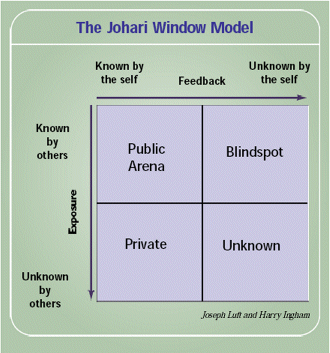 Yesterday, a Simon buddy of mine, Stan, shared with us the top-level idea of the Johari Window, a psychological model for human interaction and self-disclosure. (Joseph Luft and Harry Ingham, the principal creators of the model in 1969, labeled their model the “Joe & Harry” or “Johari” Window.) I’ve obviously been under a rock, since I was able to find a wealth of information about the subject with a simple web search.
Yesterday, a Simon buddy of mine, Stan, shared with us the top-level idea of the Johari Window, a psychological model for human interaction and self-disclosure. (Joseph Luft and Harry Ingham, the principal creators of the model in 1969, labeled their model the “Joe & Harry” or “Johari” Window.) I’ve obviously been under a rock, since I was able to find a wealth of information about the subject with a simple web search.
(See references one, two, and three for more reading about the model.)
The model is commonly used for understanding better what it takes to be an effective leader through communication, feedback, and honest discourse, which is part of the core fundamentals they teach us at Simon, especially in Professor Schmidt’s class. The model employs a four-part figure to reflect the interaction of two sources of information – self and others. The squared field, representing the “interpersonal space,” is partitioned into four regions with each region representing particular information-processing elements that have significance for the quality of relationships.
The Public Arena is the portion of the total interpersonal space devoted to mutual understanding and shared information. This known by the self / known by others facet of the relationship is thought to control interpersonal productivity. The assumption is that productivity and interpersonal effectiveness are directly related to the amount of mutually-held information. Therefore, the larger the Public Arena becomes, the more rewarding, effective, and productive the relationship is apt to be.
One can significantly influence the size of the Public Arena in relating to others by the behavioral processes you choose to use in your relationships. To the extent that you make others aware of relevant information which you have and they do not, you enlarge the Public Arena in a downward direction reducing the Private [Arena]. The process employed toward this end has been called by Luft and Ingham the Exposure Process. It entails the open and candid expression of feelings and factual knowledge.
Yet it takes two to communicate and the other party must also expose in order for communication to be productive. Therefore, active solicitation by you of the information of others must also be employed. This process is known as Feedback Solicitation. As one solicates feedback, the Public Arena extends to the right reducing your Blindspot. The overall idea is to increase your Public Arena, and thus establish truly effective relationships by engaging in optimum Exposure and Feedback solicitating behaviors.
Dear Daryl DuLong,
Hello, my name is Sujin. I’m a 28 yr old professional with work experience as a photojournalist and as a dancer. I’m interested in pursuing a research job in nonverbal communication (gestures, haptics, self-presentation) but I’m having a hard time finding a research opportunity. Would you be able to point me in the right direction? It seems like DC has a lot of think tanks but I haven’t had any luck. I’d be happy to email you my resume. Thank you.
Sujin